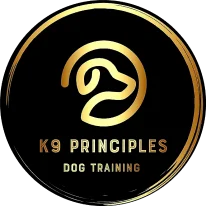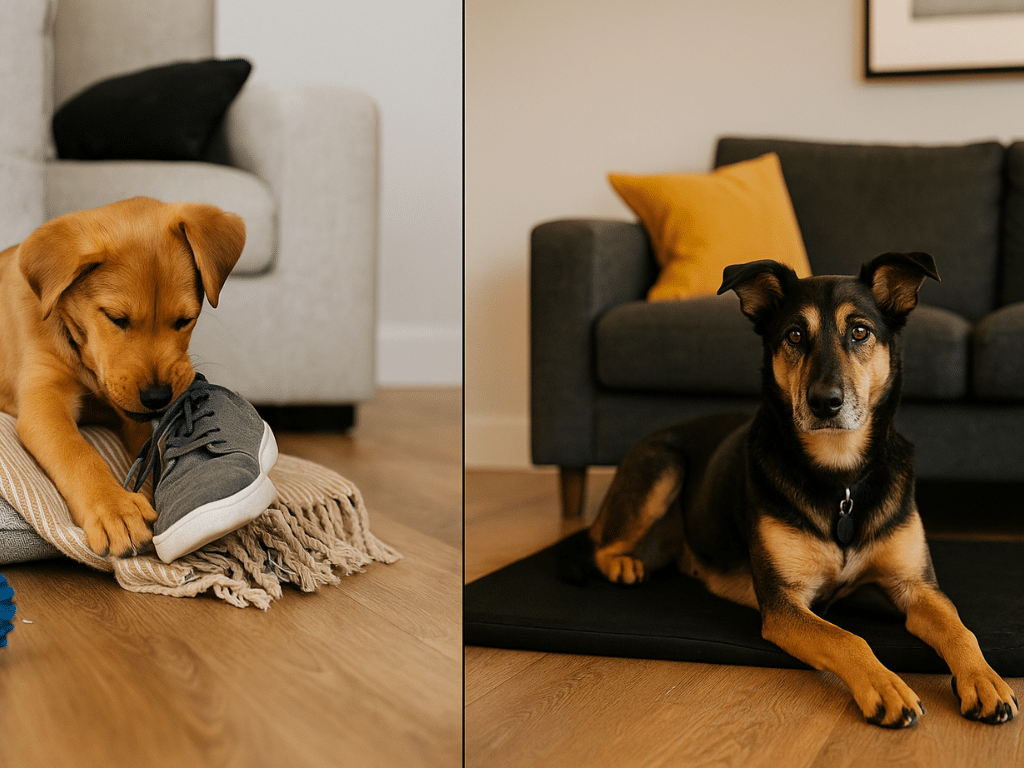Across Hamilton and the surrounding communities, families are imagining their future with a dog curled at their feet. Some feel the pull of a tiny pup with satellite ears and clumsy paws; others feel a quiet connection with a steady adult whose eyes say “I can exhale here.” Both can be brilliant choices when the timing is right. At K9 Principles, we deliver dog training in Hamilton designed for real households—work commutes, school runs, sport nights, winters that demand waterproofs, and weekends that never seem long enough. The single biggest pattern we see is simple: people underestimate how much micro-structure a puppy needs and overestimate how difficult it is to integrate a well-matched adult rescue. That mismatch creates stress, broken sleep, and reheated arguments about who forgot the 2 a.m. toilet break. This guide exists to keep you clear-eyed and confident. We will help you audit your week honestly, understand what a puppy truly asks of your timetable, and appreciate why an adult rescue might fit beautifully right now. We will also show you how either path succeeds with calm, consistent cues and a plan that respects welfare, family life, and the way new habits are formed. If you are searching for Hamilton dog training that gets to the heart of daily life, this is the place to begin.
The part no one says out loud about puppies (and why timing is everything)
Puppies are a wonder and a workload in the same breath. They learn fast, sleep deeply, explore with their mouths, nip when overtired, and rehearse whatever the environment allows. The first six to twelve weeks at home set a long shadow: toilet routines, chew habits, response to boundaries, and the meaning of everyday cues. When the household is genuinely ready for frequent toilet trips, late-night wake-ups, calm reinforcement, and short, predictable training moments tethered to meals and rest, a puppy can be an absolute joy. When the household is juggling 8–10 hour workdays, unpredictable shifts, extracurriculars, and the hope of “fitting training in,” the timeline pushes back. In our dog training in Hamilton work, the dogs that thrive are the ones whose families align timing and reality. That is not about love; it is about hours available, consistency, and follow-through. Timing does more heavy lifting than enthusiasm. When the timing is right, puppies flourish and owners enjoy the project. When the timing is wrong, even lovely families feel like they are firefighting.
A real-life week in Hamilton: the lifestyle audit that predicts success
Before shopping for crates or collars, map the week you actually live. Wake times, commutes, lunch blocks, after-school logistics, gym nights, homework, dinner, and the hour where everyone tries to decompress. Now overlay the non-negotiables of a young dog. Daytime toilet breaks at least every one to two hours in the early stretch. Supervision whenever awake to prevent rehearsing the wrong habits. Short, well-timed learning windows. Structured rest to avoid the overtired gremlin hour. Calm exposure, not a firehose of novelty. Ask the tough question: can the family deliver this cheerfully and consistently for several weeks? With dog training in Hamilton, we see the clearest predictor of success is not excitement; it is a calendared plan that ordinary Tuesdays can support. If the audit shows the bandwidth is there, the puppy timeline is realistic. If the calendar has no oxygen, an adult rescue offers the same love with a far smoother entry. That choice is wisdom, not compromise. 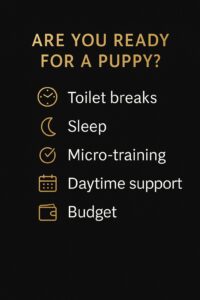
Toilet training without tears: night-time wakes, day-time rhythms, and clean floors
Toilet training is proactive, not reactive. The wins come from beating the bladder to the punch: escorting outside after waking, after meals, after play, and whenever sniff-and-circle says “now.” Inside, freedom expands with supervision; when supervision is thin, shrink the space and make the next right choice easy to find. Nights include brief wake-ups. The routine that preserves everyone’s sanity is quiet and minimal: outside, cue, success, praise, back to bed, lights low. In our Hamilton dog training programs, we normalise the pattern and set a simple, humane cadence so families avoid turning 3 a.m. into party time. Most first-time owners underestimate how often this repeats across those early weeks. If your life cannot accommodate a short season of broken sleep and a daytime rhythm of consistent escorting outside, the struggle is not a failure of commitment; it is the biology of development. Choosing an adult dog who is already house-trained allows many families to skip this intense chapter and begin with a calmer baseline. 
Work schedules and fairness: what young puppies truly need to thrive
A crate—introduced correctly—is a safe den, not a storage unit. Very young puppies cannot cope with an eight-hour absence and remain comfortable, clean, and emotionally settled. Long stretches alone make toilet training and emotional stability harder, not easier. Fairness means reliable daytime breaks, enriched rest, and a predictable pattern that balances wake, play, learn, and deep sleep. Where a household cannot arrange midday support, an adult rescue is kinder right now. Adult dogs still need company, structure, and breaks, yet most cope with longer intervals, which turns the second half of the workday from a guilt-ridden scramble into a routine you can keep. In our dog training in Hamilton planning, we design welfare-first schedules that work for human beings and the dog who will share their home.
The first 12 weeks: simple cues, deep sleep, and building a learning culture
Young dogs absorb house rules quickly when the signals are clean. We keep language simple and use “cue” rather than “command” because we want clarity, not conflict. One cue, one opportunity, one piece of feedback. Then a reset for the brain: real sleep. Sleep converts practice into habit; without it, you get a chaotic blur that frustrates everyone. We like to tether short teaching moments to anchors you already keep: doors, meals, leads, kettles, sofas. The result is a micro-curriculum woven through your day. With our Hamilton dog training, we coach timing and reinforcement so new owners feel skilful from the first session. If that micro-structure sounds exciting, a puppy is a great project. If it feels like spinning plates on a windy pier, consider the smoother start of an adult rescue who already has a few soft skills “installed” and is ready to learn the house dictionary at a calmer pace.
Fulfilment that calms (not winds up): movement, scent, stillness
Fulfilment is not about burning off steam until a young dog collapses; it is about choosing activities that lead to calm. We work with a triangle: measured movement, scent engagement, and taught stillness. Movement might be a structured potter appropriate to age or a low-arousal game with clear start and finish cues. Scent tasks put the brain to work in a way that gently drains the battery. Stillness is taught through settle on a mat, appropriate chews in a safe space, and the rhythm of breathe-down moments across the day. In our dog training in Hamilton sessions, we tailor this triangle to age, breed tendencies, and family routine. Puppies benefit from more frequent, shorter hits; many adult rescues take to stillness quickly and meet movement needs in more predictable blocks. When fulfilment is done well, the so-called “problem behaviours” either never get rehearsed or fade without a fight because the nervous system has what it needs.
The cost curve: why puppies front-load time, money, and attention
Puppies concentrate cost and effort into the early months. Vaccinations and boosters, parasite prevention, neuter or spay at the right time, puppy-safe equipment, replacements for chewed items, and structured learning support all add up. The hidden invoice is time. Every minute spent preventing a habit is a minute saved undoing it later—excellent value, but it still needs to exist in your week. With Hamilton dog training, we reframe cost around peace at home: would you rather invest the minutes now in a structured puppy plan, or invest a smaller number of targeted sessions to integrate an adult dog who arrives with some basics in place? Neither path is morally superior. One simply fits today’s reality better.
Why an adult rescue might be your best fit right now
An adult rescue often delivers a calmer entry to family life. Many are house-trained, past the chew-everything phase, and already possess soft manners that shorten the learning curve. Their energy profile is visible rather than guessed, which makes planning movement and enrichment far easier. With Hamilton dog training support, the focus shifts from building every skill from zero to refining house rules and teaching your specific cue vocabulary. Integration tends to be faster because the household can give structured attention in longer, saner blocks rather than dozens of micro-moments all day. For busy families who still want an excellent relationship with a dog, this can feel like lifting a weight from the chest.
Temperament matching with the HBSPCA: clarity beats guesswork every time
Working with the Hamilton/Burlington SPCA and K9 Principles together brings real information to the table. Shelter teams record how dogs respond to handling, new spaces, other dogs, and daily routines. That means you can choose a match for temperament and lifestyle, not just looks. As dog trainers providing dog training in Hamilton, we ask practical questions that matter: how does this dog recover from stress, what rhythms does it keep already, what soft skills are present, and which early cues will deliver the biggest relief at home? Clarity keeps surprises low and progress high. It is not about seeking a mythical “perfect dog”; it is about matching a real dog to a real life with honesty and care.
The decompression window: the first 14 days that change everything
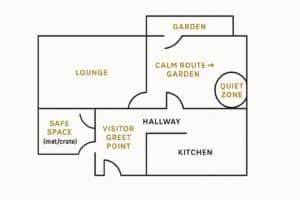 Decompression is a quiet, predictable fortnight that lets an adult dog understand the home without being swept into every errand, visitor, and outing on day one. Meals are steady, walks are short and calm, and teaching focuses on a handful of high-impact cues: settle on a mat, polite doorway behaviour, and recall foundations. Visitors are limited and routines are reassuring. In our dog training in Hamilton plans, the decompression template is personalised for the layout of your home and the flow of your days, including where the safe space lives, how we layer exposure to neighbourhood sights and sounds, and when to expand privileges. Owners consistently report that this two-week approach is the single biggest reason integration feels easy rather than edgy. It is not a trick; it is respect for how nervous systems settle when given safety and structure.
Decompression is a quiet, predictable fortnight that lets an adult dog understand the home without being swept into every errand, visitor, and outing on day one. Meals are steady, walks are short and calm, and teaching focuses on a handful of high-impact cues: settle on a mat, polite doorway behaviour, and recall foundations. Visitors are limited and routines are reassuring. In our dog training in Hamilton plans, the decompression template is personalised for the layout of your home and the flow of your days, including where the safe space lives, how we layer exposure to neighbourhood sights and sounds, and when to expand privileges. Owners consistently report that this two-week approach is the single biggest reason integration feels easy rather than edgy. It is not a trick; it is respect for how nervous systems settle when given safety and structure.
Where dog training in Hamilton fits: K9 Principles in your real life
Everything we do is built around ordinary Hamilton days. We are not training for internet clips; we are training for your streets, winters, school nights, and the five minutes before bedtime when nobody has patience left. With Hamilton dog training, we start at home to see the truth of the routine. If a puppy is coming, we map toilet opportunities, rest blocks, micro-sessions, and safe-space habits that protect learning and everyone’s sleep. We design a simple cue system and coach timing so reinforcement lands cleanly. If an adult rescue is joining the family, we run the decompression playbook and step quickly into the freedom-giving skills: recall you trust, loose-lead walking that feels like a shared stroll, greeting manners that keep visitors smiling, and an on-mat settle that makes the living room peaceful again. We keep jargon low and outcomes high because the goal is not performance; the goal is a life that works.
Building the case without guilt: the right dog, right now
If the week cannot cover toilet breaks, sleep fragmentation, supervision, and multiple tiny training windows, that is not a character flaw; it is a schedule. If the household can cheerfully carry those tasks, a puppy adventure can be brilliant. If companionship without rebuilding the entire timetable feels wiser, an adult rescue is a win for everyone—family, dog, and shelter. Because we provide dog training in Hamilton, we witness the long tail of these choices. The families who thrive chose the path that fit their present life, then trained consistently and kindly. The families who struggle tried to add a developmental project to a timetable with no space. Guilt does not help anyone learn; good planning does.
The readiness framework: a calm, confident “yes” or a wise “not yet”
Decisive checkpoints prevent heartache. Ready for a puppy means daytime toilet breaks at least every one to two hours at first, the bandwidth for a few weeks of interrupted sleep, three to five brief but high-quality learning moments daily, and protected rest so the brain can wire new patterns. If that reads like fiction while the calendar stares back, choose an adult dog now and revisit puppies later. As your partner for dog training in Hamilton, we will help you thrive either way. For puppies, we build a humane routine with minimal friction. For rescues, we drive the decompression arc and teach the skills that grant freedom—recall, loose-lead, polite greetings, and on-mat settle—so everyday life in Hamilton feels simple again. This is what effective dog training looks like when it serves the family first and the algorithm never.
Conclusion
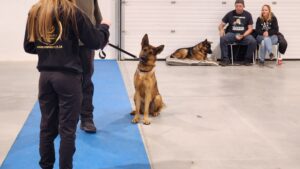
The best decisions are kind to the future. A puppy can be a brilliant, joyful project when the timetable matches the task: proactive toilet breaks, protected sleep, simple cues, and many tiny wins. An adult rescue can be a graceful start when the household wants companionship without the intensity of early puppyhood. Both paths thrive with welfare-first structure and cue-based learning that fits real Hamilton days. With K9 Principles In-Home Private dog training in Hamilton, families get plans that work in kitchens, on pavements, in parks, and on rainy school nights—because that is where life happens. Choose with clear eyes, then build the skills that grant freedom. We will be alongside you for the quiet wins that make home feel like home.
Contact us for more information:
- Name: K9 Principles
- Address: Haldimand County, Greater Hamilton Area, Burlington, and Most of Norfolk County
- Phone: 289 880-3382
- Email: k9principlesinc@gmail.com
- Website: www.k9principles.ca
FAQs
-
A1. Training starts the first hour, gently and clearly. Tie simple cues to daily anchors—doors, bowls, leads—and keep successes easy. With dog training in Hamilton, we build this into your routine so learning happens without long sessions or pressure.



